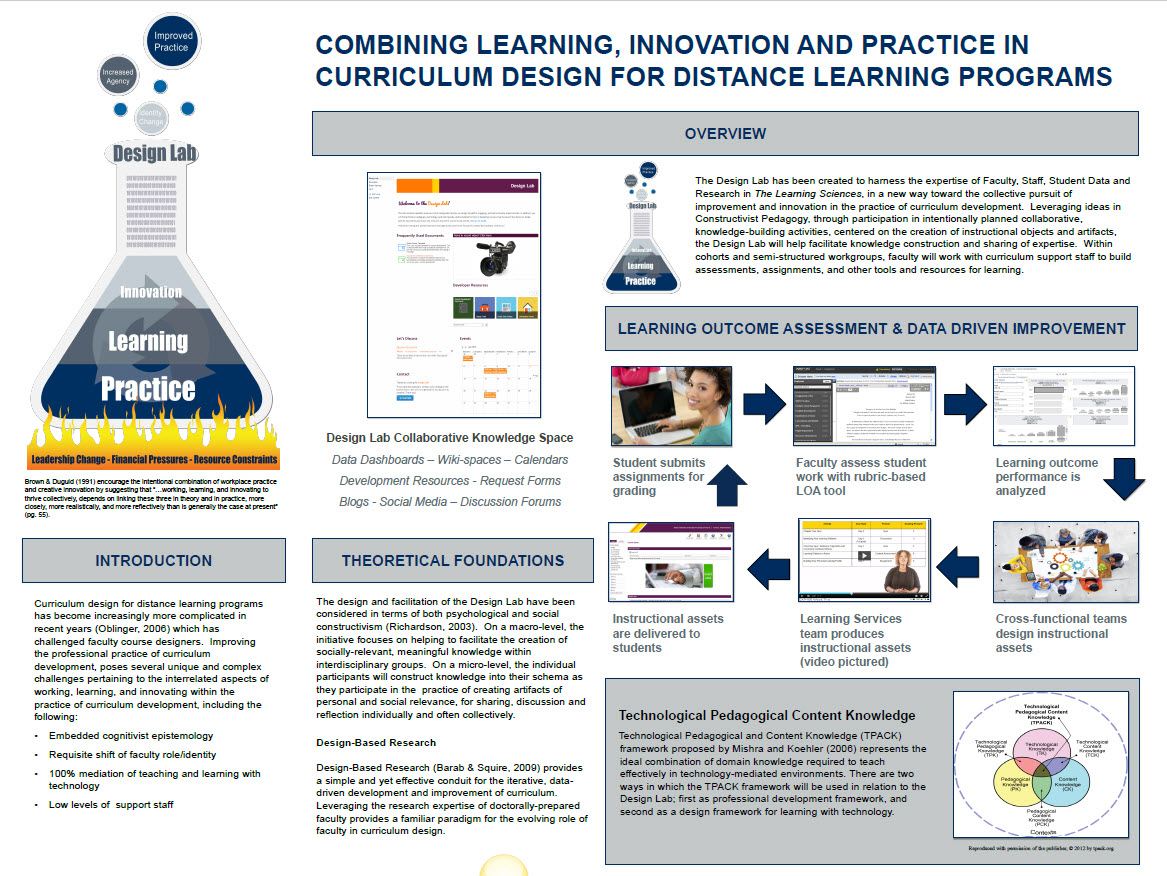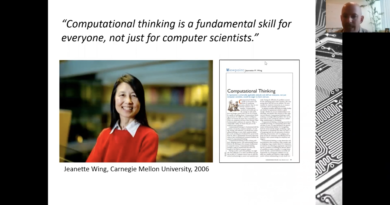Design Lab: Combining Learning, Innovation and Practice in Curriculum Design for Distance Learning Programs
Improving Curriculum Development Practice:
Improving the professional practice of curriculum development at Online University poses several unique and complex challenges pertaining to the interrelated aspects of working, learning and innovating within the practice of curriculum development. Brown & Duguid (1991) encourage the intentional combination of workplace practice and creative innovation by suggesting that “…working, learning, and innovating to thrive collectively, depends on linking these three in theory and in practice, more closely, more realistically, and more reflectively than is generally the case at present” (pg. 55). Though it has been nearly 25 years since this was written, arguably little has changed in the average workplace to close the gap, and curriculum development at Online University is no exception.
For the Design Lab to be implemented successfully at Online University, there are several challenges that must be overcome. The following discussion will survey a variety of challenges and potential solutions, examining the theoretical foundations of both the problems and design solutions involved in combining practice with learning and innovation. In order of presentation, the three major theoretical discussions supporting the Design Lab pertain to: shifting from the engrained epistemology of our formal learning environments, the importance of considering the shifting of identities within participant groups and individuals, and the complex challenges related to leveraging the affordances of technology in the construction of distance learning programs in a technology mediated environment.
Rethinking learning and Practice
Providing significant resistance to integrating learning and innovation with practice seamlessly, is the strong tradition of Cognitivist Theories of Learning and their underlying Epistemological assumptions in nearly all formal learning environments. Cognitivist theories of learning describe the acquisition of information within ones’ Long Term Memory (LTM) as foundational to the understanding of learning. Kirshner, Sweller and Clark (2006) comment on the paramount importance of long term memory when they argue that the “…long term memory is now viewed as the central, dominant structure of human cognition.” (pg.76)
The Cognitivist lens of learning provides a natural foundation for the design of formal learning environments and the development of instructional practices that attempt to maximize the acquisition of information in long term memory. Of the more widely known cognitivist theories tied deeply to traditional instructional design of learning, is Cognitive Load Theory (CLT), which describes the limitations of learning in terms the continual interplay between the limited capacity of the Working Memory (WM), and the unlimited capacity of the Long Term Memory (LTM), (Sweller, 1988). Building and organizing formal knowledge structures in the long-term memory, have been shown to be able to be accessed later without strain on working memory (Paas, et al. 2010), affording the increasing complexity of thought demonstrated as expertise.
When designing learning environments, this pursuit of continued reduction of distractions and extraneous strain on the working memory in instructional environments is a primary objective. Simultaneously the cognitivist lens encourages the pursuit of increased effectiveness of instructional delivery to improve learning. Many of our formal learning environments both public and private have been created based on this reasoning and understanding making it particularly difficult to initiate change in curriculum design.
The effects of Cognitivist Epistemology on participants of formal learning environments are widespread, and yet hardly ever described in terms of the explicit connection to the foundational assumptions in terms that make the connection clear. Regarding the effect of designing learning environments on these assumptions, Wenger (1998) writes:
“Our institutions, to the extent that they address issues of learning explicitly, are largely based on the assumption that learning is an individual process, that it has a beginning and an end, that it is best separated from the rest of our activities, and that it is the result of teaching. Hence we arrange classrooms where students – free from the distractions of their participation in the outside world – can pay attention to a teacher or focus on exercises. We design computer-based training programs that walk students through individualized sessions covering reams of information and drill practice. To assess learning, we use tests with which students struggle in one-on-one combat, where knowledge must be demonstrated out of context, and where collaborating is considered cheating. As a result, much of our institutionalized teaching and training is perceived by would-be learners as irrelevant, and most of us come out of this treatment feeling that learning is boring and arduous, and that we are not really cut out for it.”(pg. 1-2)
The traditional classroom environment, virtual learning environments and professional development programs in use today, abstract the more cerebral-focused activities of learning facts and abstracted ideas over authentic application of knowledge in practice. As Brown (1991) described, “The central issue in learning is becoming a practitioner not learning about practice.” (pg.48) yet many of our institutions of learning continue to operate blindly as if this was not the case. The resultant effects are situations where students are prepared to know about subjects, rather than learning to do or practice within the expertise within a given domain, leading to poor
With this in mind, the Design Lab, will diverge from the traditional cognitivist approach to learning and intentionally combine the workplace practices of learning, working and innovating. In the new approach to curriculum development, knowledge is not considered fixed and bound to traditional understanding, but rather created is constructed and shared within a community that works together in pursuit of new knowledge. Jenkins (2006) discusses the shift from fixed expertise to a Collective Intelligence, when he writes, “The expert paradigm requires a bounded body of knowledge, which an individual can master. The types of questions that thrive in a collective intelligence, however, are open ended and profoundly interdisciplinary; they slip and slide across borders and draw of the combined knowledge of more diverse community.” (pg. 52) Faculty, support staff and interdisciplinary groups will share the physical and conceptual space of the design lab, increasing the collaboration and community needed to improve curriculum design in ways not previously possible as individuals.
The design and planned facilitation of the Design Lab have been considered directly in terms of both psychological and social constructivism (Richardson, 2003). On a macro-level, the initiative focuses on helping to facilitate the creation of socially-relevant, meaningful knowledge within interdisciplinary groups. On a micro-level, the individual participants will construct knowledge into their schema (Sweller, 1988) and then apply it in practice in the creation of artifacts of personal and social relevance, for sharing, discussion and reflection individually and often collectively.
As is the case for any real endeavor, there are existent expectations of general outcomes, and real-world constraints of capacity and resources which will challenge the designer-participants, this will be no more impactful than similar environmental realities within other constructivist endeavors. The Design Lab was also designed in consideration of the described characteristics of Constructivist Pedagogy (Richardson, 2003, pg. 1626). These include, considerations of student-centeredness, promotion of exploratory group dialogue within relevant knowledge domains, the unplanned introduction of Formal Domain Knowledge, and opportunities for students to build knowledge through engaging in designed tasks, interwoven with mindfulness and meta-awareness of one’s own learning process as a result.
The Design Lab will leverage ideas in constructivist pedagogy, through participation in intentionally planned collaborative, knowledge building activities, and through the creation of instructional objects and artifacts. Within the cohorts and semi-structured workgroups, faculty will work with curriculum support staff to build assessments, assignments, and other tools and resources for learning. Describing the relationship between learning and the creation of objects, seminal author and theorist in Constructionist pedagogy, Seymour Papert coined the phrase Objects to think with. In the Cambridge Handbook of the Learning Sciences, Yazmin Kafai (2006) describes Papert’s Objects to think with as “objects in the physical and digital world (such as programs, robots, and games) can become objects in the mind that help to construct, examine, and revise connections between old and new knowledge” (pg. 8). As a central aspect of the Design Lab is the idea of continuous and iterative improvement of curriculum. As such, curriculum objects will regularly be reflected upon and analyzed both individually and socially within the community of practitioners that will continually be expected to make and improve upon them.





